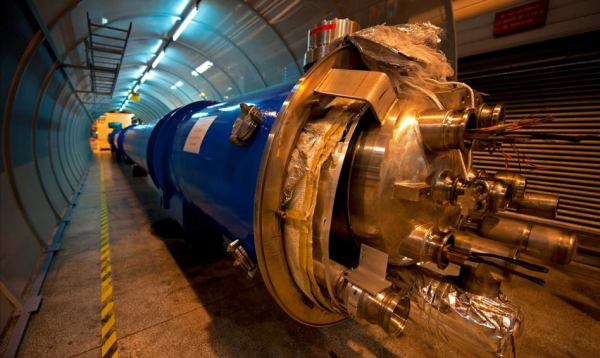In a year, the Large Hadron Collider (LHC) at CERN will begin a technical downtime that will last – including start-up – almost four years. Dr. Malika Meddahi from CERN explains to PAP that the modernization of the HL-LHC costs about 1 billion francs (about PLN 4.5 billion) and will allow for the collision of more particles in a smaller volume than at present.

“As part of the modernization, which will begin next year, we do not plan to increase the energy of collisions, but the number and quality of collisions,” emphasized Dr. Malika Meddahi in an interview with PAP during her visit to Poland at the Perspektywy Women in Tech Summit conference.
Once the upgrade is complete, the LHC will receive a new name – the High-Luminosity LHC.
The Large Hadron Collider is the world’s largest particle accelerator. It is located at CERN, the European Organization for Nuclear Research, near Geneva. Two beams of hadrons—charged particles, usually protons—circulate in opposite directions in two separate vacuum tubes, in a tunnel about 27 kilometers in circumference, 100 meters underground. The accelerator also works with ions, such as lead.
See alsoHow artificial intelligence will affect the work of accountants
Protons moving in opposite directions collide with each other at four specially designated points, at the heart of particle detectors. At the collision sites, enormous energy is released (currently about 13.6 teraelectronvolts – TeV), in which exotic particles appear for fractions of a second – those that existed just after the Big Bang. Detectors placed at the collision points record data on these phenomena. In-depth analysis of this data allows scientists to better understand the properties and interactions of elementary particles.
It was clear from the start that the LHC would operate in phases. The first data-gathering phase, Run 1, ran from 2010 to 2012. Run 2 ran from 2015 to 2018. The current phase, Run 3, began in 2022 and will last until June 2026. In between, the accelerator has undergone regular upgrades and maintenance, increasing its reliability and efficiency and enabling it to achieve new records.
This time, the downtime is needed for the LHC to improve its luminosity. In accelerator physics, luminosity means the number of collisions that occur when particle beams collide. The new beam will not only contain more particles, but will also be more tightly focused, which will increase the probability of collisions. The LHC upgrade is to increase the total number of collisions by a factor of ten. The more “luminous” LHC will allow for more precise measurements of new particles and observation of processes that have so far remained beyond the range of detector sensitivity. This will make it possible to detect rare phenomena and expand our knowledge of the Universe at this energy boundary.
However, the increased luminosity poses serious technological challenges. As part of the modernization, new quadrupole magnets are needed to hold the beam, cooling systems must be improved, and beam diagnostic systems and new device protection systems must be implemented to prevent damage. Detectors and IT systems must also be modernized to cope with the growing amount of data to be processed.
Dr. Meddahi explained that the complex of four pre-accelerators, where particles are accelerated before being injected into the LHC, has already undergone a major upgrade, which has been implemented and successfully launched, with beams that meet the HL-LHC specification already being routinely obtained.
In the LHC ring itself, on either side of the ATLAS and CMS experiments, new superconducting quadrupole magnets will be installed, which focus the beams just before they collide. They will be made of a new superconducting material based on niobium and tin.
“The upgrade is a huge undertaking. We need to open up miles of the accelerator to install the new magnets. At the same time, we will be performing maintenance and upgrading of the existing infrastructure,” Dr. Meddahi explained.
As Dr. Meddahi explained, a large part of CERN’s research and development efforts are currently focused on making new devices more efficient – using less energy and, where possible, less water for cooling. Energy recovered from the installations could be used, for example, to heat infrastructure in nearby towns.
The CERN expert also described what will happen during the long downtime. First, the entire system must gradually warm up from minus 271 degrees Celsius to room temperature. “Only then will hundreds of people be able to enter the tunnel every day and work on their equipment. This is a truly enormous task. Then everything must be reconnected, tested, cooled down again – which takes several months – and tested again. It will take almost a year to prepare the machine for restarting after the work is completed,” she noted.
The researcher added that for CERN scientists, the LHC downtime does not mean a break in their work. They will be involved in designing, assembling and testing new components. They will also analyse data collected in the ongoing Run 3 phase – a process that is much more time-consuming than data collection itself.
“What we do at our institute is true science for peace. We have people from 110 nationalities working together, putting geopolitics aside and coming together to better understand where we come from, what particles existed at the time of the Big Bang, where the missing mass and energy of the universe is… These are all fascinating questions and we as humanity should be pursuing them. We need to make sure that Europe continues to lead in this research – it is truly of great value,” assured Dr. Meddahi.
The Polish Press Agency was the media patron of the Perspektywy Women in Tech Summit (4-5 June).
Ludwik Tomal (PAP)
lt/ bar/ mhr/